Espresso
Which Espresso Has The Most Caffeine

As a coffee enthusiast, I have always been curious about which espresso has the most caffeine. It’s a question that has been asked time and time again, and the answer varies depending on a number of factors. Understanding the caffeine levels in espresso can be a bit tricky, but it’s important for those who want to get the most out of their coffee experience.
When it comes to coffee, caffeine is the main ingredient that gives the drink its stimulating effects. However, not all espresso is created equal in terms of caffeine content. There are various factors that can affect the amount of caffeine in your espresso, such as the type of bean, roast level, and brewing methods.
In this article, we will explore the different factors that contribute to the caffeine levels in espresso and provide you with information on which espresso has the most caffeine.
Key Takeaways
- Robusta beans have almost double the caffeine content of Arabica beans.
- Single-origin beans have higher caffeine content than blends.
- Darker roasts have higher caffeine content but taste more bitter.
- Espresso variations, like Ristretto, can have different caffeine content.
Understanding Caffeine Levels in Espresso
Are you curious about how much caffeine is in your espresso shot? Let’s dive into understanding caffeine levels in espresso! Caffeine is a natural stimulant that can be found in varying amounts in coffee, tea, chocolate, and energy drinks. When consumed, caffeine is quickly absorbed into the bloodstream and travels to the brain, where it blocks the action of adenosine, a neurotransmitter that promotes sleep and suppresses arousal. This leads to increased alertness and a feeling of wakefulness.
Caffeine metabolism varies from person to person, but on average, it takes about 4-6 hours for half of the caffeine to be eliminated from the body. This means that if you consume a cup of coffee containing 100 mg of caffeine, you will still have 50 mg of caffeine in your system 4-6 hours later.
It’s important to note that caffeine can also have negative effects on sleep, especially if consumed in large amounts or later in the day. It can interfere with the ability to fall asleep, reduce the quality of sleep, and increase the frequency of waking up during the night.
Now that we understand the basics of caffeine metabolism and its effects on sleep, let’s move on to how the type of bean used in espresso affects caffeine levels.
Type of Bean
When it comes to the type of bean used in espresso, there are two main players: Robusta and Arabica. Robusta beans are known for their high caffeine content and strong, bitter flavor profile, while Arabica beans are favored for their lighter, more complex flavors and lower caffeine content.
Additionally, the choice between single-origin beans and blends can greatly impact the taste and caffeine levels of your espresso. As a coffee enthusiast, I always consider the type of bean used when choosing my espresso.
Robusta vs. Arabica
If you’re looking for a bold and intense espresso with a kick like a mule, go for Robusta beans over Arabica. While Arabica beans are certainly more popular due to their complex flavors and lower acidity, Robusta superiority in caffeine content cannot be denied.
Robusta beans contain almost double the caffeine content of Arabica beans, making them the perfect choice for those who need an extra boost in the morning. However, it’s important to note that Robusta beans also come with a slightly bitter taste and lack the nuanced flavors that Arabica beans are known for.
If you’re a coffee connoisseur who values taste over caffeine content, then Arabica is still the way to go. That being said, many coffee blends combine both Robusta and Arabica beans to achieve a balance between caffeine content and flavor complexity.
In the next section, we’ll delve deeper into the differences between single-origin and blended coffee beans.
Single-Origin vs. Blends
Now, you may be wondering what the difference is between single-origin and blended coffee beans.
Single-origin coffee beans come from a specific region or farm, and have a unique flavor profile that showcases the terroir of that area.
Blended coffee beans, on the other hand, are a combination of beans from different regions or farms, carefully selected and roasted to create a desired flavor profile.
So which one has more caffeine?
-
Single-origin coffee beans tend to have a higher caffeine content than blends, as they’re typically grown at higher altitudes where the coffee cherries ripen more slowly, resulting in a denser bean with more caffeine.
-
However, blends can also have a high caffeine content if they include beans from high-altitude regions.
-
The roast level also affects caffeine content, as darker roasted beans have less caffeine than lighter roasted beans.
-
Ultimately, the caffeine content of your espresso will depend on the specific beans used, the roast level, and the brewing method.
Moving on to the next section about roast level, it’s important to note that the roast level can also affect the flavor profile of your espresso.
Roast Level
You’ll want to choose a dark roast if you’re looking for the espresso with the most caffeine. The roast level is directly linked to the caffeine content of the espresso beans. The darker the roast, the higher the caffeine content. However, this also means that the taste of the espresso will be more bitter and less nuanced.
It’s important to consider your taste preferences when choosing a roast level. If you prefer a smoother, less bitter taste, you may want to opt for a medium roast. While the caffeine content may not be as high as a dark roast, you’ll still get a good amount of caffeine without sacrificing flavor. On the other hand, if you’re solely focused on getting the most caffeine possible, a dark roast will do the trick.
While there is a correlation between roast level and caffeine content, it’s worth noting that the amount of caffeine in espresso can also vary based on the brewing method.
In the next section, we’ll explore how brewing methods can affect caffeine content.
Brewing Methods
When it comes to brewing methods, there are traditional and modern techniques to choose from. Both have their advantages and disadvantages, but what’s important is understanding their impact on caffeine extraction.
As a barista, it’s crucial to consider which technique you use when brewing espresso, as it can greatly affect the amount of caffeine in the final product.
Traditional vs. Modern Brewing Techniques
If you really want to boost your caffeine intake, try opting for the modern brewing techniques – they’ll give you a kick that’ll make your heart skip a beat! Traditional brewing techniques, such as the stovetop espresso maker or the French press, are known for producing a full-bodied and rich flavor profile. However, modern brewing techniques, like the AeroPress or the espresso machine, have gained popularity because they offer a faster and more efficient way to extract caffeine from coffee beans.
Let’s take a closer look at the pros and cons of each brewing technique and their impact on taste and aroma.
| Technique | Pros | Cons |
|---|---|---|
| Traditional | Rich flavor profile, full-bodied | Longer brew time, less efficient caffeine extraction, sediment in the cup |
| Modern | Efficient caffeine extraction, faster brew time, less sediment | Less flavor complexity, requires specialized equipment, can be expensive |
As we can see from the table, modern brewing techniques have their own set of advantages and disadvantages when compared to traditional ones. However, the impact on caffeine extraction is what truly sets them apart. Moving forward, we’ll explore how different brewing techniques affect the caffeine content of your espresso.
Impact on Caffeine Extraction
Now that we’ve discussed the differences between traditional and modern brewing techniques, let’s delve into their impact on caffeine extraction.
One of the biggest factors affecting caffeine extraction in espresso is water temperature. The hotter the water, the more caffeine is extracted. However, if the water temperature is too hot, it can cause the coffee to taste burnt. This is why it’s important to find the sweet spot for water temperature, usually between 195-205°F (90-96°C).
Another important factor is pressure. In traditional espresso machines, the pressure is typically around 9 bars, while modern machines can range from 6-15 bars. Higher pressure can lead to a higher caffeine extraction. However, pressure alone is not the only determining factor. The grind of the coffee and the tamping pressure also play a role in the extraction process.
To accurately measure caffeine levels in espresso, samples are analyzed using high performance liquid chromatography (HPLC).
Now, let’s move on to the next section where we’ll explore the different variations of espresso and their caffeine content.
Espresso Variations
When it comes to espresso variations, there are a few key differences to note. Firstly, Ristretto is a short shot of espresso that uses less water and has a more concentrated flavor.
On the other hand, Lungo is a longer shot that uses more water, resulting in a milder flavor.
Additionally, Americano is made by adding hot water to a shot of espresso, while an Espresso Shot is simply a single shot of espresso without any added water.
Ristretto vs. Lungo
You’ll get a stronger caffeine kick from a Ristretto than a Lungo since it has less water and a more concentrated flavor. Ristretto is an espresso shot that’s made with the same amount of ground coffee as a traditional shot but less water. Instead of the standard 1:2 ratio of coffee to water, a Ristretto uses a 1:1 ratio, meaning the shot is extracted with less water and a shorter brewing time. This results in a stronger, more concentrated shot that packs a punch.
On the other hand, a Lungo is an espresso shot that’s extracted with more water than a traditional shot. The ratio used in a Lungo is typically 1:3 or 1:4, meaning that the shot is diluted with more water than usual. This results in a milder, less intense flavor that’s often preferred by those who want a longer, more relaxed coffee experience. However, if you’re looking for a caffeine boost, a Ristretto is the way to go.
Moving on to the next section, let’s talk about the difference between an Americano and an espresso shot.
Americano vs. Espresso Shot
If you want a longer coffee experience, an Americano may be your go-to drink, as it’s made with hot water and an espresso shot, creating a milder flavor overall.
Unlike the Ristretto and Lungo, the Americano isn’t a preparation technique but rather a combination of two drinks. The hot water dilutes the espresso shot, creating a smoother and less intense flavor profile. The water also helps to cool the espresso, making it more palatable to those who find the flavor of straight espresso too strong.
Despite its milder taste, an Americano can still pack a punch in terms of caffeine content. The espresso shot used in the drink contains a high concentration of caffeine, making it a popular choice for those who need a quick pick-me-up. However, the overall caffeine content of an Americano will depend on the size of the drink and the amount of espresso used.
Moving on to specialty coffee shops, there are many different types of drinks available that go beyond the standard espresso, Ristretto, Lungo, and Americano. These drinks often have unique flavor profiles and preparation techniques, making them a fun and exciting option for coffee lovers.
Specialty Coffee Shops
Although specialty coffee shops offer a diverse range of espresso options, it’s essential to note that the caffeine content can vary depending on the type of roast and brewing method utilized.
Many specialty shops promote ethically sourced and artisanal blends, and they often prioritize sustainability practices. However, these factors do not necessarily correlate with higher caffeine content.
When it comes to caffeine content, it’s important to consider the brewing method. Specialty coffee shops often use manual brewing methods, such as pour-over or French press, which can result in a stronger cup of coffee with higher caffeine content.
However, when it comes to espresso, the brewing method is standardized, and the caffeine content is primarily determined by the amount of coffee used and the roast level.
In general, darker roasts tend to have less caffeine than lighter roasts because the roasting process breaks down caffeine molecules. Therefore, if you’re looking for high caffeine content in your espresso, it’s best to go for a lighter roast.
In the next section, we’ll explore the caffeine content of popular espresso brands and how they compare to each other.
Caffeine Content of Popular Espresso Brands
I know that specialty coffee shops are a great go-to when looking for a quality cup of espresso. However, when it comes to caffeine content, there are variations between popular espresso brands that can satisfy different taste preferences. This leads me to the current subtopic: caffeine content of popular espresso brands.
-
First, it’s important to note that caffeine content can vary based on the type of bean, roast level, and brewing method.
-
Lavazza, a popular Italian espresso brand, boasts a higher caffeine content compared to other brands due to their use of Robusta beans.
-
Illy, another Italian brand, uses a blend of Arabica and Robusta beans resulting in a lower caffeine content but a smoother taste profile.
-
On the other hand, Starbucks, an American brand, offers espresso shots with a higher caffeine content due to their use of a darker roast and a larger serving size.
Understanding caffeine content variations between popular espresso brands allows for a personalized coffee experience based on individual taste preferences. For those who prefer a stronger, higher caffeine content, Lavazza or Starbucks may be the go-to brands. However, for those who prefer a smoother taste with a lower caffeine content, Illy may be the better option.
As we continue to explore the world of espresso, it’s important to also consider those who prefer a decaffeinated option. This brings us to the subsequent section about decaffeinated espresso.
Decaffeinated Espresso
Decaffeinated espresso is a viable option for those who want to enjoy the taste of espresso without the caffeine. Decaffeinated alternatives are made by removing caffeine from the coffee beans through a chemical or water process. This process ensures that the coffee still retains its rich and creamy flavor, but with a significantly reduced caffeine content.
While decaf may be a great option for those who are sensitive to caffeine, it also has its health benefits and drawbacks. Decaf coffee has been shown to help lower the risk of heart disease, diabetes, and certain types of cancer. However, it may still cause acid reflux and disrupt sleep patterns due to its high acidity and residual caffeine content.
Considering the health benefits and drawbacks of decaf, it’s important to make an informed decision based on personal preferences and health conditions. In the next section, we’ll explore the various health considerations to keep in mind when choosing between regular and decaf espresso.
Health Considerations
Now that we’ve discussed decaffeinated espresso, let’s shift our focus to the health considerations of consuming regular espresso. While espresso can provide an energy boost and improve cognitive function, it’s important to understand the potential risks and benefits associated with its consumption.
Firstly, excessive consumption of espresso can lead to negative side effects such as increased heart rate, high blood pressure, and anxiety. It’s important to consume espresso in moderation, and to be aware of your personal tolerance level. Additionally, it’s important to consider the potential risks associated with the additives commonly found in espresso, such as sugar and cream.
On the other hand, there are also potential health benefits associated with moderate espresso consumption. Studies have shown that moderate consumption of espresso can lower the risk of certain diseases such as Parkinson’s and Alzheimer’s. Additionally, espresso contains antioxidants which can help to reduce inflammation in the body.
While espresso can provide an energy boost and potential health benefits, it’s important to consume it in moderation and to be aware of the potential risks associated with excessive consumption and additives. As with any food or beverage, it’s important to make informed decisions and to consider the individual needs and preferences of your own body.
Frequently Asked Questions
Can decaf espresso still provide any caffeine?
Decaf espresso still provides a small amount of caffeine, although significantly less than regular espresso. The amount of caffeine in decaf espresso can vary depending on the brewing process and the type of beans used.
However, the benefits of decaf espresso go beyond just caffeine content. Decaf espresso can still provide the rich taste and aroma of regular espresso without the jitters or sleep disturbances that can come with consuming too much caffeine. Additionally, decaf espresso has been shown to have antioxidant properties and can potentially help reduce the risk of certain diseases.
So, if you’re looking for a tasty coffee alternative without the caffeine buzz, decaf espresso can still be a great option.
How does the caffeine content in espresso compare to other types of coffee?
When comparing caffeine levels in different coffee roasts, it’s important to note that espresso typically has more caffeine per serving than other types of coffee. This is because espresso is made by forcing hot water through finely ground coffee beans, resulting in a concentrated and potent drink.
However, the exact amount of caffeine in espresso can vary depending on factors such as the type of bean used, the brewing method, and the serving size. Despite this, consuming caffeine in moderation can have a range of benefits, including increased focus, improved athletic performance, and reduced risk of certain diseases.
It’s important to remember, however, that excessive caffeine intake can have negative effects on the body, such as increased heart rate and anxiety. As with any food or beverage, it’s important to consume caffeine in moderation and listen to your body’s individual needs.
Can the size of the espresso shot affect the caffeine content?
When it comes to caffeine content, the size of an espresso shot can definitely affect it. As a barista, I’ve learned that the amount of caffeine extracted from the coffee grounds is dependent on the amount of water that’s used.
A standard espresso shot uses about 7 grams of coffee and 1 ounce of water, which results in a concentrated and strong shot. However, if you increase the size of the shot, the caffeine extraction efficiency decreases and you end up with a weaker shot.
This is because the water has less time to extract caffeine from the grounds. So, if you’re looking for the most caffeine in an espresso shot, stick with the standard size.
Is it possible for specialty coffee shops to alter the caffeine content of their espresso?
As a coffee expert, I can confidently say that specialty coffee shops have the ability to alter the caffeine content of their espresso.
Through altering brewing techniques and using different types of beans, coffee shops can adjust the flavor profile of their espresso, which can also affect the caffeine content.
For example, using a darker roast typically results in a bolder flavor and slightly less caffeine, while a lighter roast is known for having a brighter flavor and higher caffeine content.
Additionally, some coffee shops may add caffeine powder or extracts to their espresso to increase the caffeine content.
However, it’s important to note that altering the caffeine content of espresso can be a delicate process and should only be done by trained professionals who understand the nuances of coffee brewing.
Are there any potential negative side effects of consuming too much caffeine from espresso?
When it comes to consuming too much caffeine from espresso, there are certainly potential negative side effects to consider. While caffeine can provide a temporary energy boost, regularly consuming high amounts can lead to long term effects such as increased heart rate, high blood pressure, and anxiety.
Additionally, consuming too much caffeine can lead to difficulty sleeping and disrupted sleep patterns. It’s important to monitor your caffeine intake and follow recommended guidelines, which suggest a daily maximum of 400mg of caffeine for healthy adults.
It’s also worth noting that the caffeine content of espresso can vary depending on a variety of factors, including the type of beans used and the brewing method.
Conclusion
Well folks, after all that research and testing, I can confidently say that the answer to the question of which espresso has the most caffeine is not a straightforward one. There are numerous factors that can affect the caffeine levels in your cup of espresso, including the type of bean used, the roast level, and the brewing method.
However, if you’re looking for a general rule of thumb, darker roasts tend to have less caffeine than lighter roasts, and longer extraction times can result in more caffeine in your cup. It’s important to keep in mind that everyone’s sensitivity to caffeine can vary, so what may be a strong cup of espresso for some may not be as potent for others.
Overall, when it comes to caffeine in espresso, it’s all about finding what works best for you and your individual preferences. Just like how a painter chooses their brush and paint colors, finding the perfect espresso is like painting a masterpiece. It takes time, patience, and experimentation to find the perfect blend that suits your taste buds.
So go ahead, grab a cup of your favorite espresso and enjoy the unique flavors and aromas that each cup has to offer.
Arf, an author and an innovative enthusiast of coffee, coffee alternatives, and tea, plays a crucial role as a contributor to the esteemed Cappuccino Oracle platform. Renowned for his curiosity and passion for these captivating beverages, Arf has carved out a unique space for himself in the world of exploration and writing. He realized that coffee, coffee alternatives, and tea are not mere drinks to keep one awake, but universes of flavors and stories waiting to be explored.
Arf’s articles for Cappuccino Oracle blend meticulous research with personal experiences, providing readers with an in-depth understanding of various types of coffee, coffee alternatives, and tea, along with their unique characteristics, cultures, and histories. His honest reviews and engaging narratives guide readers on their own journeys, helping them discover their preferences and find their perfect brew.
Espresso
Unleash Your Inner Barista: Brewing Espresso in the Great Outdoors

Are you tired of the boring routine of making your morning coffee inside? We have a new and exciting experience for you! Picture waking up to the tranquil beauty of nature, with stunning views all around, while savoring the delicious taste of gourmet coffee.
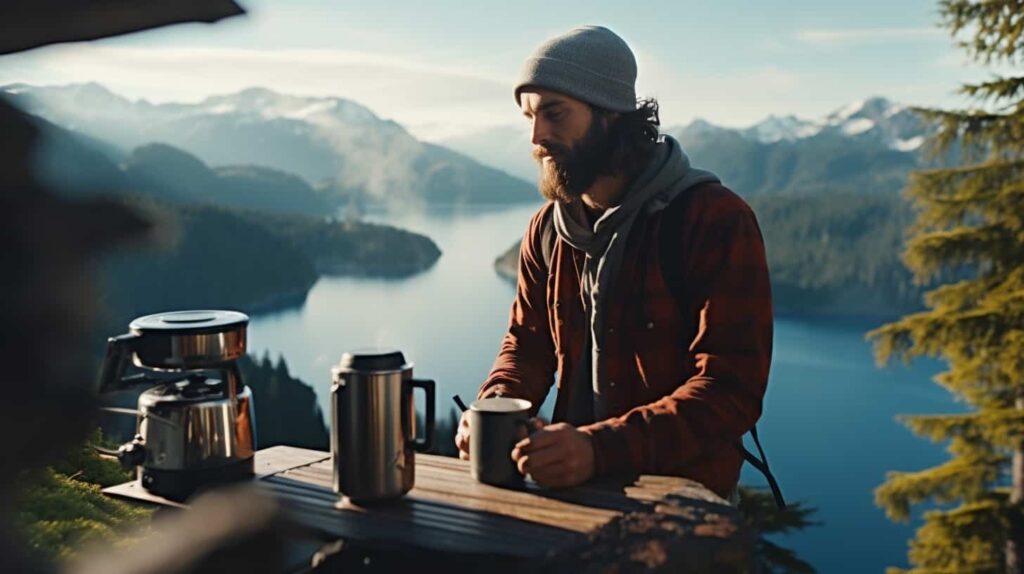
In this article, we’ll guide you on how to unleash your inner barista and brew espresso in the great outdoors. So, grab your equipment and join us on this exciting journey of becoming a barista in nature’s embrace.
Let’s get brewing!
Key Takeaways
- Brewing espresso outdoors allows you to experience peace and tranquility, connect with nature, and appreciate the brewing process.
- To enhance your outdoor espresso brewing experience, adjust the grind size using the Flair Royal hand grinder and pre-measure your coffee beans for consistency.
- It is important to be responsible in the outdoors by packing out used coffee grounds and trash, following local waste disposal regulations, and incorporating sustainable practices.
- The Flair PRO 2 Manual Espresso Maker offers easy maintenance, versatile brewing techniques, and complete control over the brewing process, resulting in exceptional espresso quality.
The Equipment You’ll Need
First, let’s talk about the equipment you’ll need to brew espresso in the great outdoors. When it comes to brewing espresso outside, choosing the right location is key. Find a serene spot, surrounded by nature’s beauty, where you can immerse yourself in the process.

Now, let’s not forget the importance of water quality. For a truly exceptional espresso, start with pristine water. Consider using filtered or bottled water to ensure the purest flavor.
As for the equipment, you’ll need a reliable water heating system, like the JetBoil Flash, to achieve the perfect temperature. Pair it with the Flair PRO 2 Manual Espresso Maker and the Flair Royal Hand Grinder for precision grinding and extraction.
With these tools in hand, you’ll be ready to unleash your inner barista and create a magical espresso experience in the great outdoors.
Benefits of Brewing Outside
Why should we choose to brew espresso outside and experience the benefits it offers? Brewing espresso in the great outdoors allows us to embrace nature while indulging in our passion. It is a truly immersive experience that brings us closer to the process and the flavors we love. Imagine waking up to the peaceful escape and tranquility of nature, surrounded by spectacular views and breathtaking landscapes.
As we brew our espresso, we feel connected to the earth, mindful of our actions, and grateful for the moment. The whole process becomes a mindful experience, where we savor each step and each sip.
Brewing outside creates memorable moments, allowing us to appreciate the beauty of nature while enjoying our favorite drink. It’s an intimate journey that combines the art of brewing with the wonders of the natural world.

Benefits of Brewing Outside Embracing Nature While Brewing Peaceful Escape and Tranquility Feel the serenity of nature while brewing your espresso. Spectacular Views and Breathtaking Landscapes Surround yourself with the beauty of the outdoors as you enjoy your drink. Embracing the Process and Connection with Nature Connect with the earth and the brewing process, feeling grounded and in harmony. Mindful Experience and Indulging in Flavors Engage your senses, appreciating every sip and the flavors that nature provides. Creating Memorable Moments Forge lasting memories as you combine your love for brewing with the wonders of nature.
Tips for Outdoor Espresso Brewing
Here are some essential tips to enhance our outdoor espresso brewing experience:
-
Grind Size Adjustment: The key to a perfect espresso lies in the grind size. With the Flair Royal hand grinder, we’ve the flexibility to adjust the grind size to our preference. Whether we prefer a fine grind for a bold and intense flavor or a coarser grind for a smoother taste, the choice is in our hands.
-
Pre-Measuring Coffee Beans: To ensure consistency and convenience in our outdoor brewing, it’s essential to pre-measure our coffee beans. By weighing and pre-dosing the coffee, we can eliminate guesswork and achieve the perfect coffee-to-water ratio every time. This step not only saves time but also guarantees a delicious cup of espresso.
-
Practicing Patience and Enjoying the Journey: Outdoor espresso brewing is more than just making a cup of coffee. It’s about embracing the process, being mindful of our surroundings, and immersing ourselves in the experience. Take a moment to appreciate the aroma, savor each sip, and create lasting memories in the great outdoors.

With these tips, we can elevate our outdoor espresso brewing to new heights of flavor and enjoyment.
Being Responsible in the Outdoors
Let’s talk about the importance of being responsible in the outdoors when brewing espresso.
As passionate coffee enthusiasts, it’s crucial that we prioritize sustainable practices and leave no trace behind. When enjoying our outdoor brewing adventures, we must remember to pack out used coffee grounds and trash, minimizing our impact on the environment.
It’s essential to be environmentally aware and follow local waste disposal regulations, preserving the beauty of nature for future visitors. By incorporating sustainable practices, such as using reusable coffee filters and opting for biodegradable packaging, we can make a positive difference.

Let’s embrace our love for espresso while also being mindful of the impact we’ve on the outdoors. Together, we can create memorable moments and protect the environment we cherish.
Introducing the Flair PRO 2 Manual Espresso Maker
We are excited to introduce the Flair PRO 2 Manual Espresso Maker, a compact and portable coffee maker that allows us to brew high-quality espresso in the great outdoors. With its sleek design and exceptional performance, the Flair PRO 2 is a must-have for coffee enthusiasts who crave a rich and flavorful espresso experience.

Here are three reasons why the Flair PRO 2 is the perfect companion for your outdoor brewing adventures:
-
Easy Maintenance: The Flair PRO 2 is built to last, with durable materials and a simple cleaning process. Its removable brew head and portafilter make maintenance a breeze, ensuring that your espresso maker stays in top shape.
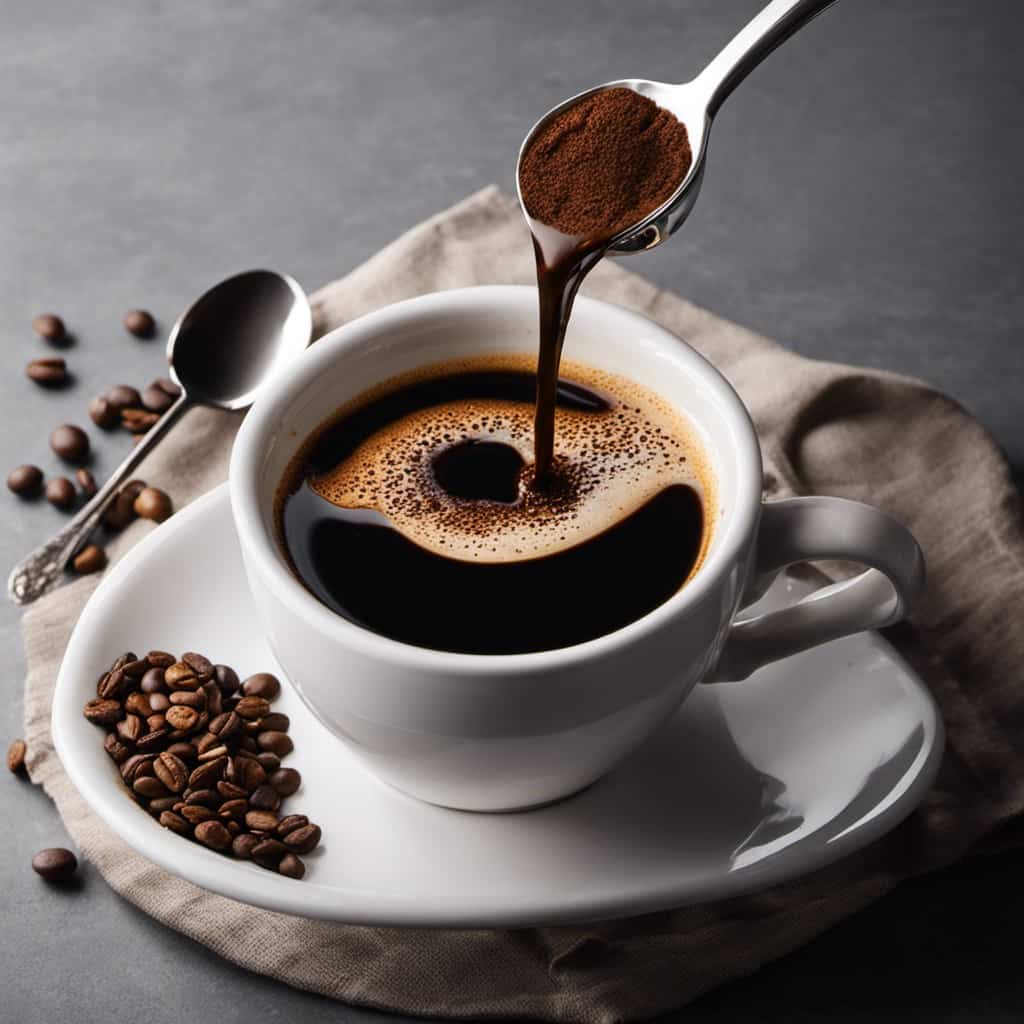
-
Versatile Brewing Techniques: The Flair PRO 2 offers a wide range of brewing techniques, allowing you to experiment and tailor your espresso to your taste. From manual pre-infusion to pressure profiling, this espresso maker gives you complete control over every aspect of the brewing process.Exceptional Espresso Quality: The Flair PRO 2 is designed to deliver exceptional espresso shots, with its precise temperature control and pressure regulation. Whether you prefer a smooth and balanced flavor or a bold and intense shot, the Flair PRO 2 will consistently produce espresso of the highest quality.
With the Flair PRO 2 Manual Espresso Maker, you can elevate your outdoor brewing experience to new heights. From maintenance to brewing techniques, this espresso maker has everything you need to unleash your inner barista in the great outdoors.
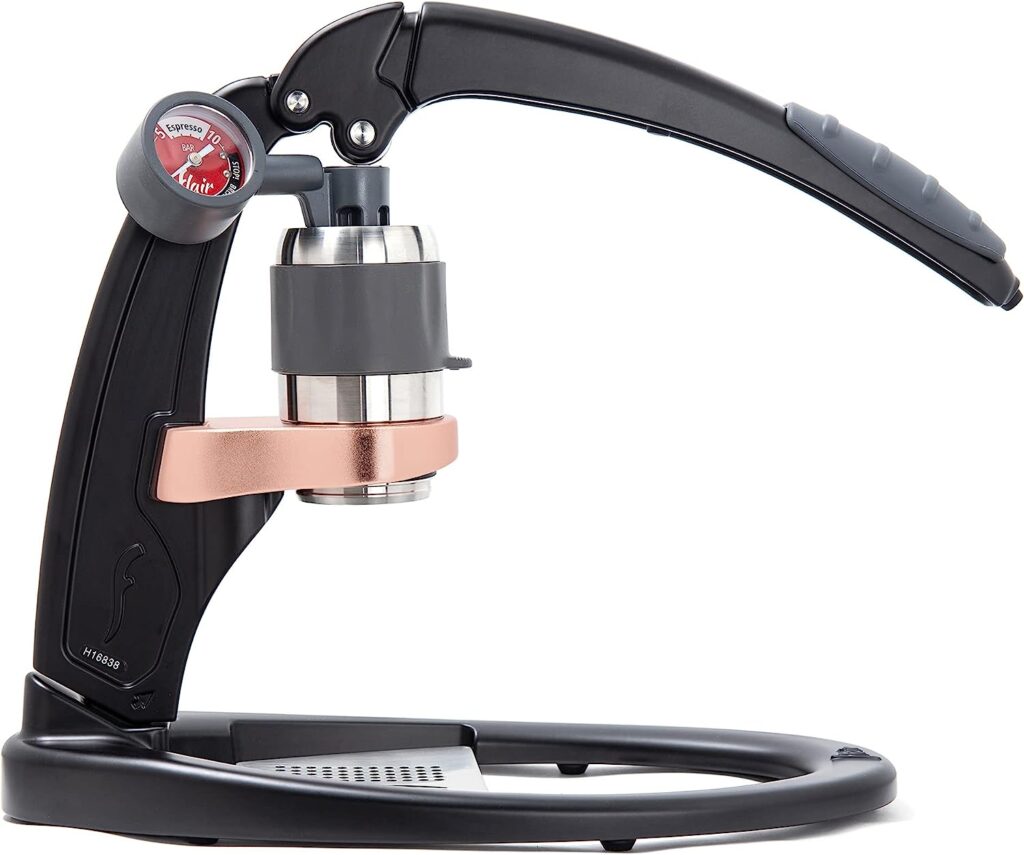
Compact and Portable Design
With its compact and portable design, the Flair PRO 2 Manual Espresso Maker is the perfect espresso machine to take on your outdoor adventures.
This sleek and lightweight espresso maker is specifically designed to be easily transported, allowing you to enjoy your favorite espresso wherever your explorations may take you. Its compact size ensures that it won’t take up much space in your backpack or camping gear, making it an ideal companion for any outdoor enthusiast.
The Flair PRO 2 Manual Espresso Maker’s portability doesn’t compromise on performance either. It’s equipped with high-quality components and features that deliver exceptional espresso shots, ensuring that you can savor the rich flavors and aromas of specialty coffee even in the great outdoors.
Precision Grinding With the Flair Royal Hand Grinder
To achieve the perfect grind size for your outdoor espresso brewing, we recommend using the Flair Royal Hand Grinder and carefully adjusting the settings to ensure precision and consistency. The grind size adjustment feature of the Flair Royal Hand Grinder allows you to have full control over the extraction process, maximizing the flavors and aromas in your espresso.
Here’s why the Flair Royal Hand Grinder is the ideal choice for precision grinding:
-
Consistent Grind: The grinder’s high-quality burrs ensure a uniform grind size, resulting in a balanced extraction and a rich, flavorful espresso.
-
Easy Adjustment: With its simple and intuitive grind size adjustment mechanism, you can easily switch between fine, medium, and coarse settings to match your desired brewing method.
-
Maximizing Extraction: By dialing in the grind size, you can optimize the extraction process, ensuring that the water extracts the desired flavors from the coffee grounds, resulting in a well-balanced and delicious cup of espresso.
The Flair Royal Hand Grinder is the perfect companion for outdoor espresso brewing, providing the precision necessary to create a truly exceptional coffee experience.

Using Specialty Coffee for Optimal Flavor
For the best flavor experience, we recommend brewing your outdoor espresso with specialty coffee. Specialty coffee beans are carefully selected and roasted to bring out the unique flavors and characteristics of each variety. When choosing the right beans for your outdoor brewing, consider factors such as origin, roast level, and flavor profile. Experiment with different varieties to find your preferred taste.
To further enhance the flavor of your outdoor espresso, it’s important to use brewing techniques that bring out the best in your chosen beans. Adjusting the grind size, water temperature, and extraction time can all impact your espresso’s flavor profile.
Try using a coarser grind and a higher water temperature for a bright and fruity espresso. For a more balanced and chocolaty flavor, opt for a finer grind and a slightly lower water temperature.
Table: Brewing Techniques for Different Flavors
Flavor Profile Grind Size Water Temperature Bright and Fruity Coarser Higher Balanced and Chocolaty Finer Slightly Lower
Reliable Water Heating System for Quick Boiling
We rely on a portable and efficient water heating system, like the JetBoil Flash, to quickly boil water for our outdoor espresso brewing. When it comes to brewing espresso in the great outdoors, having a reliable water heating system is crucial. Here’s why the JetBoil Flash is our go-to choice:
-
Speed: With its powerful burner, the JetBoil Flash can bring water to a rolling boil in just a matter of minutes. This means we can enjoy our espresso without any unnecessary waiting around.
-
Convenience: The JetBoil Flash is compact and lightweight, making it easy to transport and set up wherever we go. Its simple and intuitive design allows for effortless operation, even in the most remote locations.
-
Versatility: While the JetBoil Flash excels at boiling water, it also offers alternative heating options, such as simmering and frying. This versatility allows us to expand our outdoor cooking options beyond espresso, making it a valuable addition to our camping gear.
With the JetBoil Flash by our side, we can confidently brew our espresso in the great outdoors, knowing that we’ve a reliable and efficient water heating system at our disposal.

Embrace Your Inner Barista in the Great Outdoors
As coffee enthusiasts, experiencing the great outdoors allows us to embrace our inner barista and connect with the art of brewing espresso. There’s something truly magical about being surrounded by nature, with the soothing sounds of birds chirping and the gentle breeze caressing our faces, as we prepare our favorite cup of coffee.
It’s a moment of tranquility and connection with the world around us. Mindful coffee brewing in the outdoors allows us to fully appreciate the process, from weighing and pre-dosing the coffee beans to carefully adjusting the grind size. We can take our time, savoring the aroma and flavors, while immersing ourselves in the beauty of our surroundings.
It’s a chance to create lasting memories and indulge in the simple pleasures of life. So, let’s grab our equipment, find a serene spot, and let nature inspire our inner barista.
Frequently Asked Questions
Can I Use a Different Manual Espresso Maker for Outdoor Brewing?
Yes, you can use a different manual espresso maker for outdoor brewing. There are many portable espresso makers for camping that offer the convenience and quality you need to enjoy a delicious espresso in the great outdoors.

How Do I Determine the Ideal Grind Size for My Outdoor Espresso Brewing?
To determine the ideal grind size for outdoor espresso brewing, we carefully adjust the grind while considering the desired brew time. This ensures a rich and flavorful cup of espresso that perfectly captures the essence of the outdoors.
Are There Any Specific Types of Specialty Coffee That Work Best for Outdoor Espresso Brewing?
The best coffee beans for outdoor brewing techniques should be specialty beans from reputable local roasters. They offer optimal flavors that enhance the outdoor espresso experience, creating a truly indulgent and memorable moment.
Can I Use a Different Water Heating System Instead of the Jetboil Flash?
Yes, there are alternative water heating systems you can use instead of the Jetboil Flash. We have found success with other portable options like the MSR PocketRocket or the Primus Lite+.
What Are Some Additional Ways to Minimize My Impact on the Environment While Brewing Espresso Outdoors?
To minimize our impact on the environment while brewing espresso outdoors, we can prioritize eco-friendly coffee bean sourcing and opt for sustainable packaging options. It’s important to make conscious choices that align with our values and protect the planet we love.
Conclusion
As we bid farewell to the comforting routine of brewing espresso indoors, we embark on a thrilling journey of becoming outdoor baristas.
With the Flair PRO 2 Manual Espresso Maker as our trusty companion, we unlock a world of rich flavors and breathtaking views.
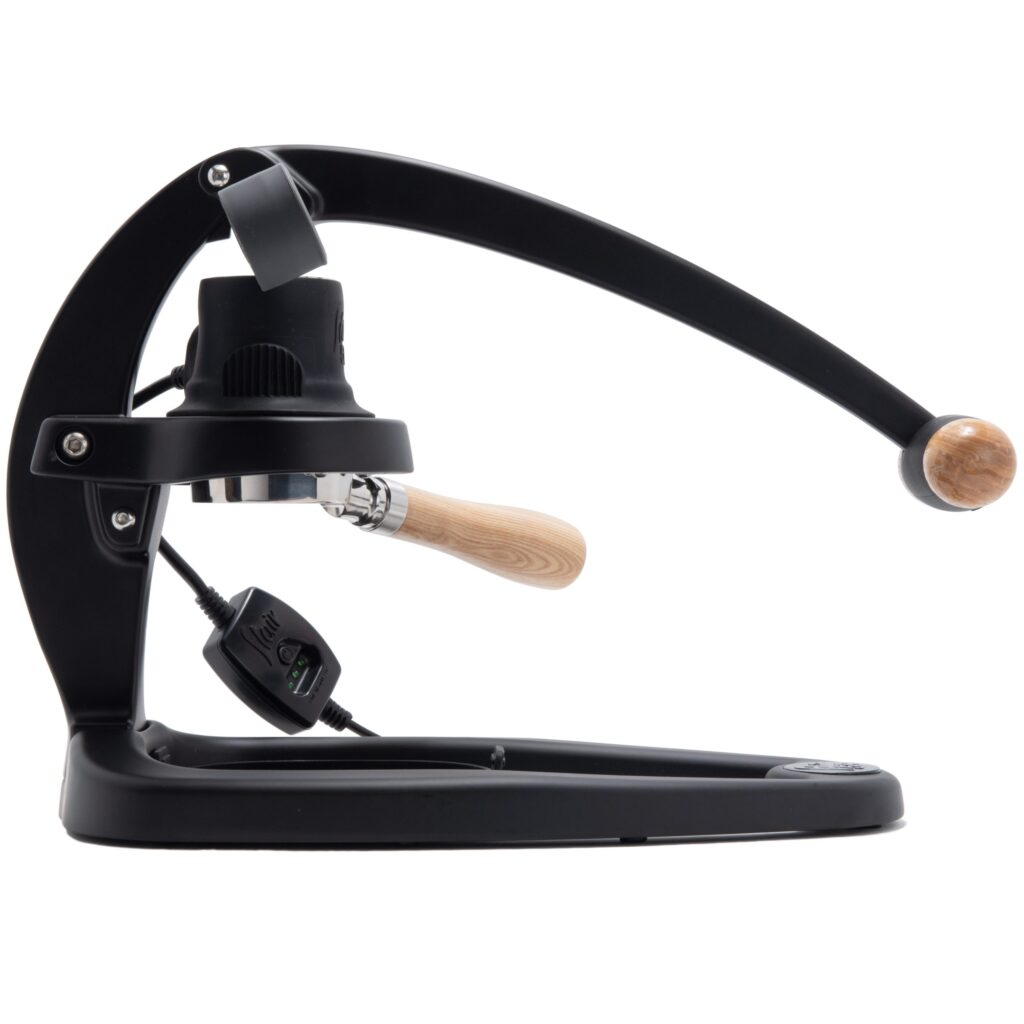
Let nature’s serenity and specialty coffee’s aroma awaken your senses and ignite your passion for the art of outdoor brewing.
So, grab your gear, embrace your inner barista, and let’s make memories in the great outdoors!
In the vast and diverse world of coffee, coffee alternatives, and tea, Olivia has found her calling. As an author and a dedicated coffee and tea aficionado, her work for Cappuccino Oracle reflects her profound love and understanding of the intricate complexities found within these beverages. Olivia’s passion for the subject serves as both a catalyst for her creativity and a connection point with her audience.
Olivia’s appreciation for coffee, coffee alternatives, and tea blossomed at an early age. She discovered that these beverages invigorated her senses and stimulated her creative spirit. From the nuanced flavors of single-origin roasts to the captivating narratives intertwined with coffee, coffee alternatives, and tea trade and culture, Olivia found an unlimited source of inspiration in her daily cup.
Her love for these beverages and her talent for storytelling eventually converged at Cappuccino Oracle. As an author, Olivia’s mission is to illuminate the intricate tapestry that makes up the world of coffee, coffee alternatives, and tea. Her articles span a diverse range of topics, encompassing everything from the unique flavors of different brews to the sociocultural history intertwined with their cultivation and consumption.
Espresso
Mochaccino – What Is It and How Do You Make It at Home
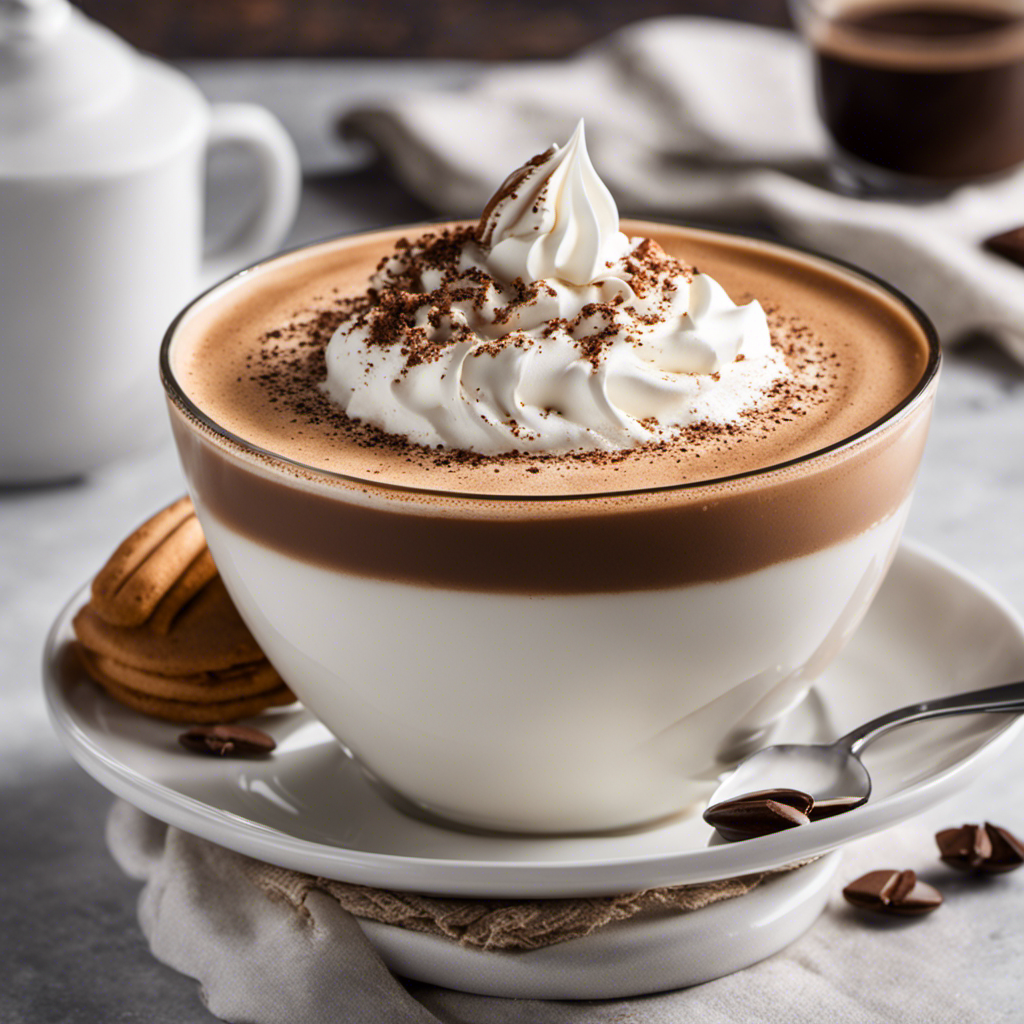
Have you ever pondered what makes a mochaccino so irresistibly delicious? Let me share with you that it’s the impeccable combination of bold espresso, creamy chocolate, and frothy milk.
And the best part? You can easily make this indulgent treat right in the comfort of your own home. In this article, I’ll guide you through the history, ingredients, and step-by-step process of creating the perfect homemade mochaccino.
Get ready to impress your taste buds and become your very own barista!
Key Takeaways
- The mochaccino originated in Italy in the 17th century as a combination of espresso and hot chocolate.
- The flavors of the mochaccino have evolved over time, with variations including caramel, vanilla, and peppermint.
- The cultural significance of the mochaccino varies in different countries.
- To make a homemade mochaccino, you will need strong brewed coffee, cocoa powder, milk, sugar, and whipped cream for topping.
History of the Mochaccino
I’ve read about the history of the mochaccino, and it’s fascinating how this delightful drink has evolved over the years.
The mochaccino, also known as a mocha, originated in Italy in the 17th century. It started as a combination of espresso and hot chocolate, creating a rich and indulgent beverage.
As time went on, the flavors of the mochaccino began to evolve. Today, you can find variations with added flavors like caramel, vanilla, or even peppermint.
In different countries, the cultural significance of the mochaccino varies. In Italy, it’s a staple in their coffee culture, while in the United States, it has become a popular choice among coffee enthusiasts.
The mochaccino has truly become a global favorite, adapting to different tastes and preferences around the world.
Ingredients for a Homemade Mochaccino
I can make a delicious homemade mochaccino with just a few simple ingredients and a little bit of time.
The key to a perfect mochaccino is combining the rich flavors of coffee and chocolate. For this, you’ll need strong brewed coffee, cocoa powder, milk, sugar, and whipped cream for topping.
To start, mix cocoa powder with a small amount of hot water to create a smooth paste. Then, heat milk on the stovetop until hot but not boiling. Add the cocoa paste and sugar to the milk, stirring until dissolved.
Next, pour the coffee into a mug and slowly pour the milk mixture over it. Finally, finish with a dollop of whipped cream. It’s a delightful treat that combines the best of both worlds – coffee and chocolate.
And if you’re looking for coffee alternatives or health benefits, a homemade mochaccino is a perfect choice.
Step-by-Step Guide to Making a Mochaccino at Home
With just a few simple steps and some common ingredients, you can easily make a delicious mochaccino at home. Here’s how:
-
Start by brewing a strong cup of coffee using your preferred method. You can use a traditional drip coffee maker, a French press, or even try alternative brewing methods like pour-over or cold brew for a unique flavor profile.
-
While your coffee is brewing, warm up some milk on the stove or in the microwave. You can use any type of milk you prefer, such as dairy milk, almond milk, or oat milk.
-
Once your coffee is ready, pour it into a mug and add a tablespoon or two of cocoa powder. Mix until the cocoa powder is fully dissolved.
-
Finally, pour the warm milk into the mug and stir well. You can also top it off with some whipped cream or chocolate shavings for an extra indulgent touch.
Making your own mochaccino at home not only allows you to control the quality of ingredients but also offers health benefits. The coffee provides a boost of energy and can improve cognitive function, while cocoa powder is rich in antioxidants and can boost mood. Additionally, using alternative milk options can cater to dietary preferences or restrictions.
Variations and Additions to the Classic Mochaccino Recipe
There are many ways to elevate the classic mochaccino recipe, such as adding a dash of cinnamon or a drizzle of caramel syrup for a hint of sweetness. But have you ever considered exploring different types of mochaccinos for their unique flavors and health benefits? Let’s take a look at some interesting variations:
| Type | Flavor Profile | Health Benefits |
|---|---|---|
| Matcha Mochaccino | Earthy and Creamy | High in antioxidants |
| Coconut Mochaccino | Rich and Nutty | Boosts metabolism |
| Protein Mochaccino | Creamy and Filling | Provides muscle recovery |
These different types of mochaccinos not only offer a diverse range of flavors but also come with their own set of health benefits. Now that we’ve explored the possibilities, let’s move on to some tips and tricks for perfecting your homemade mochaccino.
Tips and Tricks for Perfecting Your Homemade Mochaccino
To achieve the perfect homemade mochaccino, don’t forget to froth the milk until it reaches a creamy consistency. Frothing the milk adds that luxurious touch to your drink, creating a velvety texture that perfectly complements the rich flavors of chocolate and espresso.
Here are some tips and tricks to help you perfect your homemade mochaccino:
-
Use high-quality coffee beans: The best coffee beans for a mochaccino are those with a bold flavor profile. Look for beans with a rich, chocolaty undertone to enhance the chocolate flavor in your drink.
-
Experiment with homemade coffee alternatives: If you’re looking to switch things up, try using alternative coffee options like cold brew or espresso powder. These can add a unique twist to your mochaccino.
-
Adjust the sweetness: Mochaccinos are typically sweet, but you can adjust the sweetness to your preference. Add more or less chocolate syrup or sweetener to achieve the perfect balance for your taste buds.
-
Get creative with toppings: Don’t forget the finishing touches! Whipped cream, chocolate shavings, or a sprinkle of cinnamon can elevate the presentation and add an extra layer of flavor to your homemade mochaccino.
Frequently Asked Questions
Can I Use Regular Coffee Instead of Espresso in a Homemade Mochaccino?
Yes, you can use regular coffee instead of espresso in a homemade mochaccino. However, using espresso will give your drink a stronger and richer flavor, which is one of the benefits of using it.
How Many Calories Are in a Homemade Mochaccino?
I made a homemade mochaccino with whole milk and dark chocolate syrup. It has around 200 calories, but the nutritional value may vary depending on the ingredients used.
Can I Use Almond Milk Instead of Cow’s Milk in a Homemade Mochaccino?
Yes, almond milk can be used as a dairy-free alternative in a homemade mochaccino. It provides a creamy texture and a nutty flavor that complements the coffee and chocolate.
What Type of Cocoa Powder Is Best for Making a Mochaccino at Home?
When making a mochaccino at home, it’s important to choose the best cocoa powder. Look for high-quality brands, like Ghirardelli or Valrhona, for a rich and delicious flavor. Don’t forget to consider alternative milk options, like almond milk, for a dairy-free version.
Can I Make a Mochaccino Without a Milk Frother?
Sure, you can make a mochaccino without a milk frother. There are alternative methods like using a whisk or a handheld frother. These frothing techniques will give you a similar creamy texture.
Conclusion
In conclusion, the mochaccino is a beloved coffee beverage that combines the rich flavors of chocolate and espresso.
By following the step-by-step guide and using high-quality ingredients, you can easily make a delicious mochaccino at home.
Don’t be afraid to get creative with variations and additions to suit your taste.
With a little practice and a few tips and tricks, you’ll be able to perfect your homemade mochaccino and enjoy this indulgent treat whenever you like.
Justin is a seasoned author, coffee and tea enthusiast, and an essential member of the Cappuccino Oracle team. With a keen appreciation for the complexities of coffee, coffee alternatives, and tea, Justin has dedicated his professional career to exploring these realms and sharing his insights with readers worldwide.
Justin’s immersion in the world of coffee, coffee alternatives, and tea began at a young age, kindling a passion that extended beyond mere consumption. This love for these beverages led him to combine his talent for writing with his devotion to coffee and tea, bringing him to Cappuccino Oracle as a dedicated author.
Espresso
Iced Macchiato – What Is It and How to Make It at Home
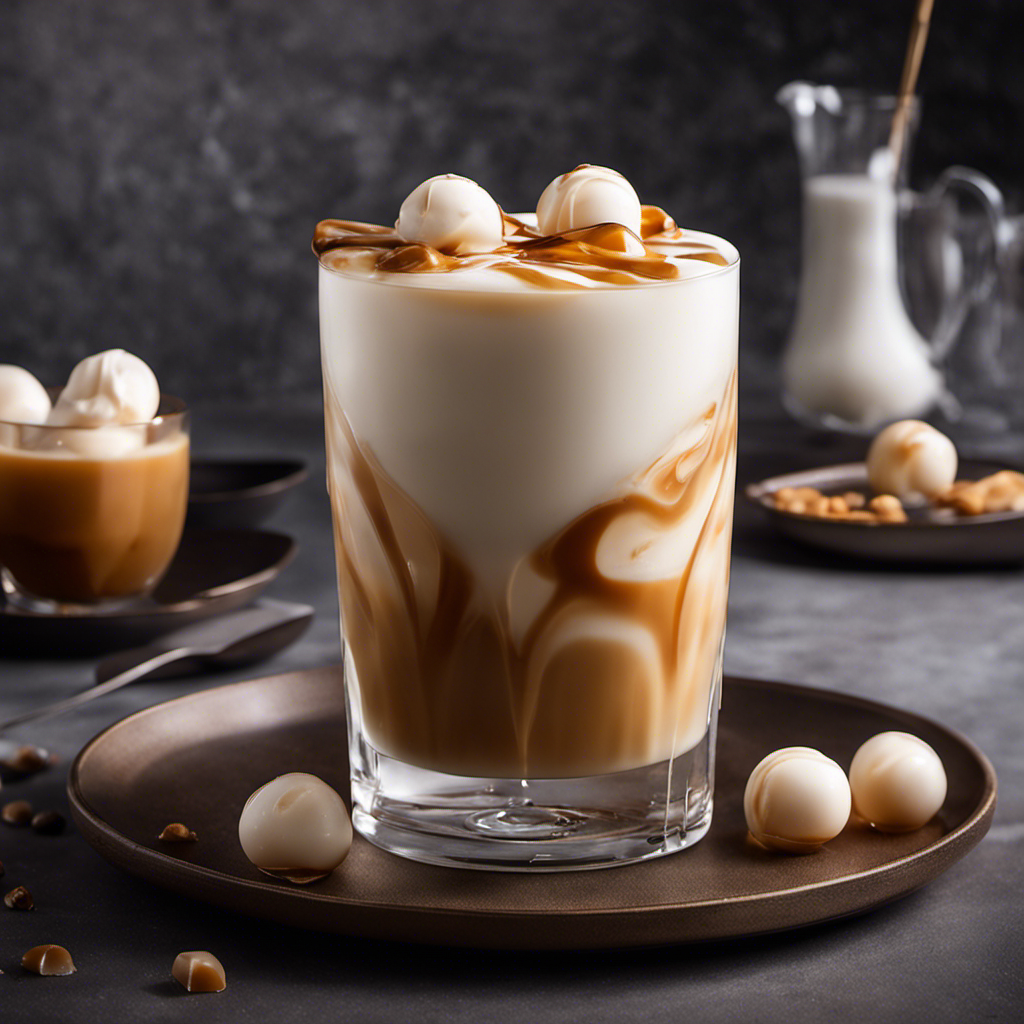
I enjoy a delicious iced macchiato on a warm summer day. Were you aware that it’s surprisingly simple to prepare at home? With just a few basic ingredients and some knowledge, you can savor this invigorating coffee drink whenever you desire.
In this article, I’ll share with you the secrets to making the perfect iced macchiato, from brewing the espresso to frothing the milk.
So grab your favorite mug and let’s get started!
Key Takeaways
- Iced macchiato originated in Italy as a variation of traditional macchiato.
- The base ingredients of an iced macchiato are espresso, milk, sweetener (optional), and ice.
- Brewing espresso for an iced macchiato requires precision and consideration of factors like grind size, brewing time, and water temperature.
- Frothing milk for an iced macchiato involves using techniques like using cold milk, alternative milk options, and a steam wand or frother.
The Origins of Iced Macchiato
I’ve always been curious about the origins of the iced macchiato. This popular coffee beverage has its roots in Italy, where the term ‘macchiato’ means ‘stained’ or ‘marked.’ Traditionally, a macchiato is made by adding a small amount of espresso to a cup and then ‘staining’ it with a dollop of frothed milk.
The iced macchiato, however, is a variation that emerged in recent years. It’s made by pouring espresso over a glass filled with ice and then adding a small amount of milk or milk foam. The result is a refreshing and flavorful drink, perfect for hot summer days.
Nowadays, there are many variations of the iced macchiato, with different flavors and toppings added to enhance the taste. From caramel to vanilla to chocolate, there’s an iced macchiato for every coffee lover’s preference.
Understanding the Ingredients
Understanding the ingredients is essential for making a delicious iced macchiato at home. When it comes to flavor profiles, the combination of sweet and bitter is what makes an iced macchiato so enticing. Here are some key ingredients to consider:
- Espresso: The base of an iced macchiato, providing a strong and rich flavor.
- Milk: Adds creaminess and balances out the espresso’s intensity.
- Sweetener: Optional, but commonly used to enhance the overall taste.
- Ice: Keeps the drink refreshing and cold.
- Optional flavorings: Vanilla, caramel, or chocolate syrups can be added for extra flavor.
Understanding different brewing methods is also important. Whether you prefer using an espresso machine, a French press, or a moka pot, each method can influence the taste and strength of your iced macchiato. Experimenting with different brewing techniques and ratios will help you find the perfect balance of flavors for your homemade iced macchiato.
The Art of Brewing Espresso
Brewing espresso is an intricate process that requires precision and skill. To achieve the perfect cup, espresso brewing techniques and the importance of water temperature can’t be overlooked.
When it comes to espresso brewing techniques, there are various methods to choose from. Some popular ones include the classic manual espresso machine, the convenient pod-based system, and the modern espresso machine with advanced features. Each technique requires careful consideration of factors such as grind size, brewing time, and pressure.
However, one common factor that’s crucial in all techniques is water temperature. The ideal water temperature for brewing espresso is between 195°F and 205°F. This range ensures proper extraction of flavors and oils from the coffee grounds, resulting in a rich and balanced espresso shot.
Transitioning to the next section, after perfecting the espresso shot, the focus shifts to perfecting the milk froth.
Perfecting the Milk Froth
I absolutely love experimenting with different techniques to perfect the milk froth for my iced macchiatos. It’s an art form in itself, and getting that perfect creamy texture on top of my espresso is essential for a delicious drink.
When it comes to creating the perfect milk froth, there are a few things to consider. Here are some tips to help you explore alternative milk options and troubleshoot common frothing issues:
- Use cold milk: Starting with cold milk will help create a better froth.
- Choose the right milk: Experiment with different types of milk, such as almond, oat, or soy, to find the one that froths best for you.
- Froth the milk properly: Use a steam wand or a frother to create a creamy and velvety texture.
- Watch the temperature: Overheating the milk can result in a burnt taste, so make sure to stop frothing when the milk reaches around 150°F.
- Clean and maintain your equipment: Regularly clean your steam wand or frother to ensure optimal frothing performance.
By following these tips, you’ll be on your way to creating the perfect milk froth for your iced macchiatos, and exploring alternative milk options along the way.
Happy frothing!
Step-by-Step Guide to Making Iced Macchiato at Home
To make an iced macchiato at home, I followed a simple step-by-step guide using a shot of espresso, a splash of milk, and a drizzle of caramel syrup.
First, I brewed a strong shot of espresso and let it cool.
Then, I filled a glass with ice and poured the espresso over it.
Next, I added a splash of milk, using almond milk as an alternative option for a creamy and nutty flavor.
To enhance the taste, I drizzled caramel syrup over the top, giving it a sweet and indulgent twist.
The beauty of making an iced macchiato at home is that you can get creative with variations.
You can experiment with different types of milk, such as oat milk or coconut milk, to suit your preferences.
Additionally, you can add flavored syrups like vanilla or hazelnut to customize your macchiato even further.
Enjoy this refreshing and satisfying beverage right in the comfort of your own home.
Frequently Asked Questions
What Is the Nutritional Content of an Iced Macchiato?
The nutritional content of an iced macchiato depends on the ingredients used. It can provide benefits such as a boost of energy from caffeine, but may also have health concerns like added sugars or high calorie content.
Can I Use Any Type of Milk to Make an Iced Macchiato?
I can use any type of milk to make an iced macchiato. Options like almond, oat, or soy milk can be used as alternatives. Additionally, different types of sweeteners can enhance the flavor.
How Long Does It Take to Brew Espresso for an Iced Macchiato?
To brew espresso for an iced macchiato, I recommend using an espresso machine and grinding fresh coffee beans. It typically takes about 25-30 seconds to extract the espresso. Froth the milk using a frother or steam wand until it reaches a creamy consistency.
Can I Use a Regular Blender to Froth the Milk for an Iced Macchiato?
Yes, you can use a regular blender to froth the milk for an iced macchiato. It’s a convenient and cost-effective alternative. You can also explore different milk options like almond, oat, or soy for a unique twist.
Can I Customize the Flavor of an Iced Macchiato by Adding Syrups or Toppings?
Yes, you can customize the flavor of an iced macchiato by adding syrups or toppings. It’s a great way to experiment with different milk alternatives and create your own unique and delicious drink.
Conclusion
In conclusion, making an iced macchiato at home is a simple process that can be mastered with practice. By understanding the origins of this popular drink, familiarizing oneself with the ingredients, and perfecting the art of brewing espresso and frothing milk, anyone can enjoy a delicious iced macchiato from the comfort of their own home.
Fun fact: Did you know that iced macchiatos are the most popular coffee choice among millennials, accounting for 40% of their coffee orders?
Noah, the Editor-in-Chief at Cappuccino Oracle, plays a pivotal role in shaping the voice and vision of our renowned platform. With an unwavering passion for coffee, coffee alternatives, and tea, Noah leads Cappuccino Oracle towards new horizons in the realm of coffee journalism.
Beyond his professional responsibilities, Noah serves as a mentor and guiding force for his team. His dedication to journalistic excellence and genuine love for coffee, coffee alternatives, and tea continue to inspire and motivate the Cappuccino Oracle family. In the ever-evolving world of these beverages, Noah’s leadership ensures that our platform remains at the forefront, delivering enlightening and enjoyable content to our readers worldwide.
-

 Coffee Basics3 days ago
Coffee Basics3 days agoThe Ultimate Guide To Buying Nespresso Pods: Where And How?
-

 Coffee Basics6 days ago
Coffee Basics6 days ago11 Best Medium Roast Coffees For Your Perfect Cup
-

 Coffee Basics6 days ago
Coffee Basics6 days agoStarbucks Venti Drinks: Customization And Pricing Guide
-

 Coffee Basics2 days ago
Coffee Basics2 days agoPerfect Your Espresso With Puck Screens: A Barista’s Secret
-

 Coffee Basics5 days ago
Coffee Basics5 days agoWhat Is Half-Caff Coffee? (And How Much Caffeine Is In It?)
-

 Coffee Basics5 days ago
Coffee Basics5 days ago9 Best Ground Coffee Brands For Your Perfect Cup
-

 Coffee Basics6 days ago
Coffee Basics6 days agoCan You Froth Oat Milk? Yes, And Here Are Six Ways To Do So
-
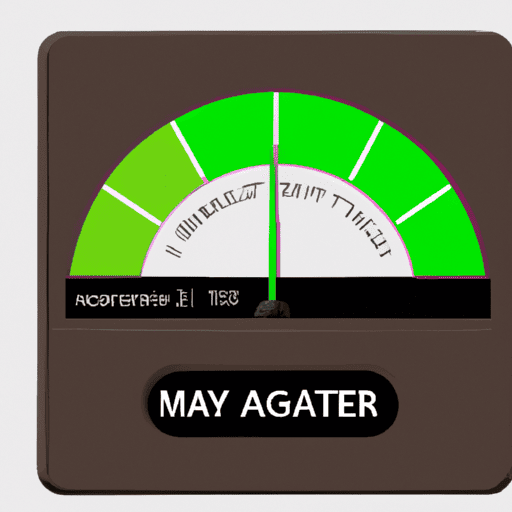
 Coffee Basics6 days ago
Coffee Basics6 days agoMaximizing Efficiency: Coffee Maker Wattage Guide






























